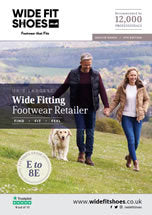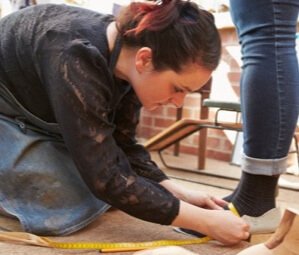Shoes for Orthotics
Best Shoes for Orthotics

Have you been advised that you need to wear orthotics in your shoes but aren’t sure exactly what that means for your everyday life or choice of footwear? Many people have to wear corrective devices in their shoes and can still find stylish and comfortable shoes and sandals to wear. It does not mean that you are doomed to a world in which you have to hide your feet because your shoes are hideous until the cause of your lower limb affliction has been resolved.
What are Orthotics?
Orthotics is a “catch-all” term that refers to just about any device that can be worn inside a shoe. They can be bought at retail stores, online or made to measure. The custom molded varieties are fit by specialists who can design a device that will provide the precise characteristics to provide relief from pain, make walking easier, treat fallen arches and reduce the risk of injury to patients.
Types of Orthotic for orthopaedic shoes
Orthotics fall into two different categories: functional and accommodative types.
Functional orthotics
Functional orthotics are made to support an abnormal foot structure or form of movement. Usually made of plastic, they are useful for treating conditions like flat feet. They also help with absorbing shock when you are either walking or running.
Accommodative orthotics
Accommodative orthotics are devices like braces and splints. They are used for relief of minor foot pain and to correct minor problems with the foot.
Ankle-foot Orthotics
Ankle-foot orthotics, or AFOs are made to control either your ankle’s position or motion. It is used to compensate for weakness or a deformity in the joint. AFOs are a common type of orthotic device, and they are sometimes called braces.
AFOs or braces may be recommended for people who have suffered a stroke or who need support for a weakened or wasted limbs. Some people with a foot drop or arthritis can also find them helpful. Braces can be either have a flexible or rigid design, depending on the desired result.
Cushioned Heel
A cushioned or SACH (Solid Ankle Cushioned Heel) heel is a wedge of compressible rubber that is placed into the heel of a shoe to reduce impact when the wearer takes a step. It also reduces knee movement in the wearer.
Heel Wedges
Heel wedges are used to encourage the front foot to either turn inward or outward when taking a step. They also prevent the hind foot from sliding down the incline created by the wedge.
Heel Flares
A heel flare is inserted into a shoe to resist turning inward or outward and to provide stability to the foot.
Inner Sole Excavation
This is a soft pad that is filled with squeezable materials that can be placed under the ball of the foot. Once it is placed in a shoe, it reduces pressure on the wearer’s foot.
How to Look for Shoes for Orthotics
It can be a bit challenging to find footwear that is compatible with orthotic inserts. A standard pair of shoes may not be the right choice when you wear a corrective device. At Wide Fit Shoes, we carry a number of styles for men and women which are compatible with orthotics.
-
A Removable Insole
This feature will allow the orthotic to sit deeper inside the shoe and will give it a solid base. It will also mean that your heel will fit deeper into the heel counter much better. You will be less likely to encounter fit problems by removing the insole, as well as any arch supports, felt or rubber additions before inserting any orthotics into the shoe.
If the shoe is flat, you can place your orthotic directly over top of the insert if it does not make the shoe fit too tight.
-
Shoes that are Adjustable
Lace-up styles or ones with adjustable straps or buckles are good choices if you need to make allowances for an orthotic device. You should always bring your orthotic with you when buying shoes so that you can try it on with the shoes that you are considering.
Lace-up styles or ones with adjustable straps or buckles are good choices if you need to make allowances for an orthotic device. You should always bring your orthotic with you when buying shoes so that you can try it on with the shoes that you are considering.
If you find that your orthotic is making your heel slip in your shoes, it does not mean that you need to consider buying a smaller size. Instead, look at a lace-up pair of footwear and ask our shoe experts about different lacing techniques to help reduce heel slippage and increase your comfort.
Be Sure to Keep your Shoes in Good Condition
Take good care of your shoes if you need to wear orthotics. Allowing them to become worn down without replacing them will only make it more challenging for the orthotic to perform effectively, since it may not fit correctly in your shoe.
Whether you are being fitted for your first orthotic or have been using them for some time, contact Wide Fit Shoes for the right fit for shoes for orthotics for you. Like plantar fasciitis, orthotics can be painful if not looked after.
5 Ways Custom Orthotics Can Improve Your Feet
Have you been considering the use of custom orthotics, but are unsure if you really need them? Well, we have found five reasons you do need custom orthotics and how they can change the way your feet and body feel.
-
Orthotics Correct Foot, Knee, and Back Pain
A person will take an average 8,000 to 10,000 steps per day, not counting any time spent exercising. This is an example of how much punishment your body undergoes daily. Without proper maintenance to care for the daily wear and tear of your body, your body will begin to respond with pain. It could be heel, knee, or back pain. This caused by the pressure you are applying by conducting everyday activities. Custom orthotics can help alleviate this pain and keep your body within proper alignment while walking. This is giving it the proper maintenance it needs to meet the days head on.
-
Uneven Feet Are Common
Did you know that you may have one foot larger than the other? Statistics show that this is a common feature on the majority of the population. Custom orthotics are available to help give your feet an even fit.
-
Women Are More In Need Of Orthotics
Women are more likely to suffer from foot aliments due to their footwear. Women wear more varieties of footwear than men that fluctuated in sizes and fittings. They tend to shop for the best look instead of the best comfort for their feet. High heeled shoes of 2.5” or more will increase the pressure on the foot by 75%. Orthotics will help eliminate any issues caused from improper footwear and they are offered in stylish choices.
-
Standing for Long Periods of Time Is Damaging
If you are required to stand in the same spot for extended periods of time, then you are harder on your feet than those who walk. By standing you are forcing the same muscles that allow you to move to hold their position. This could cause long-term pain and damage to the foot, ankle, and knee areas. Custom Orthotics will elevate the unnecessary pressure caused from static muscles.
-
Orthotic Can Promote Drier Feet
Did you know that your feet excrete half a pint of moisture a day? This is because your feet carry 250,000 sweat glands. A custom orthotic will allow your feet to breathe easier and assist in eliminating the moisture contained by your shoes. Not only will you have drier feet but the odour will become much more pleasant to the senses, not to mention there is less risk of fungal infections taking place.
BROWSE OUR RANGE OF MEN'S SHOES FOR ORTHOTICS
DISCOVER OUR RANGE OF WOMEN'S WIDE ORTHOPEDIC SHOES
Sources
- www.nhs.uk/Conditions/Lymphoedema/Pages/Introduction.aspx
- www.circulationfoundation.org.uk/help-advice/other-vascular-information/lymphoedema/
- physio.ie/services/orthotics/five-key-facts-about-orthotics/
- www.apma.org/Learn/FootHealth.cfm?ItemNumber=988
- orthoticsfeet.com
- www.usaorthotics.com/blog/5-more-facts-about-your-feet-and-custom-orthotics







